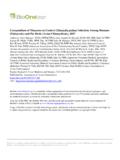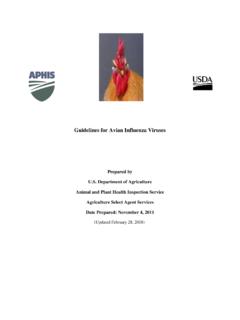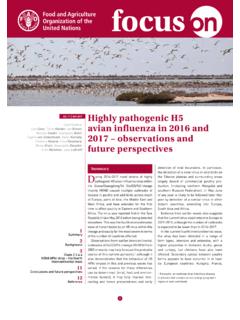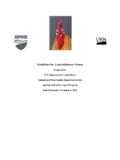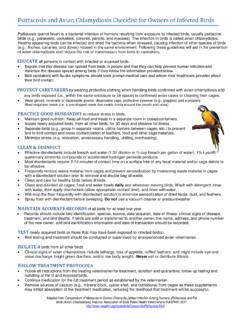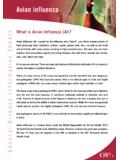Transcription of OIE Situation Report for Avian Influenza
1 OIE Situation Report for Avian Influenza 19 September 2017 1 OIE Situation Report for Avian Influenza Latest update: 18/09/2017 This Report presents an overview of current disease events reported to the OIE by its Members. The objective is to describe what is happening currently, explain what we are seeing, and consider what might happen next. The epidemiology of Avian Influenza is complex. The virus constantly evolves and the behavior of each new type (and strains within types) and the risks they present can vary, as will the response in different countries. So the global Situation must be considered as distinct epidemics that share some characteristics.
2 We briefly present the key risks driving current events - how the strains are interacting with hosts (both wild birds and poultry, and sometimes humans) and the environment (season and climate, livestock husbandry systems, ecosystems) and how the event may evolve in the months ahead. OIE Situation Report for Avian Influenza 19 September 2017 2 Current Global Situation (ongoing outbreaks as of 18 of September 2017) 1. Avian Influenza strains causing disease events. Strain Count of countries affected Increase /Decrease in countries from last Report (07/08/2017) # of ongoing outbreaks in poultry # of ongoing outbreaks in wild birds Increase/Decrease in ongoing outbreaks from last Report (07/08/2017) A Aggregated count of poultry destroyed for ongoing outbreaks Number of poultry destroyed since the last Report (07/08/2017) H5N1 8 2 17 0 6 131 168 7441 H5N2 1 0 182 1 6 1 617 816 39 456 H5N5 2 -1 0 2 -1 0 0 H5N6 3 1 358 0 4 25 096 648 401 625 H5N8 16 2 277 51 43 4 355 879 427 081 H7N9 1 -1 22 0 -2 831 087 0 Total 856 54 56 32 032 598 857 603 Table 1.
3 Global Situation for on-going outbreaks of Highly Pathogenic Avian Influenza in poultry and wild birds by strains OIE Situation Report for Avian Influenza 19 September 2017 3 2. Regional Situation Region Count of countries affected by ongoing outbreaks Percentage of countries within the Region List of countries Difference regarding last Report List of Strains Aggregated count of poultry destroyed for ongoing outbreaks Number of poultry destroyed since the last Report (07/08/2017) Africa 8 15% Cameroon, Congo (Dem. Rep.), Egypt, Niger, Nigeria, South Africa, Togo, Zimbabwe. 0 H5N1, H5N8 1 478 697 425 629 Americas 0 0% -1 0 0 Asia and the Pacific 8 22% China, Chinese Taipei, India, Korea (Rep.)
4 Of), Laos, Myanmar, Philippines, Vietnam. 3 H5N1, H5N2, H5N6, H5N8, H7N9 29 888 335 448 598 Europe 7 13% France, Germany, Italy, Montenegro, Russian Federation, Slovenia, Switzerland. 1 H5N5, H5N8 665 566 1 376 Middle East 0 0% 0 0 Total 23 13% 32 032 598 875 603 Table 2. Regional Situation for on-going outbreaks of Highly Pathogenic Avian Influenza in poultry and wild birds OIE Situation Report for Avian Influenza 19 September 2017 4 3. Events declared closed since the last Report Country No events closed since 07/08/2017 Species Strain China 1 Wild H5N1 Egypt 1 Poultry and Wild H5N8 Germany 3 Poultry and Wild H5N5, H5N8 Slovakia 1 Poultry H5N8 United Kingdom 3 Poultry and Wild H5N8 United States of America 1 Poultry H7N9 4.
5 Epidemic curve: Global epidemic curve of the number of outbreaks by week (since October 2016) Figure 1. Epidemic curve showing the weekly incidence of outbreaks of Highly Pathogenic Avian Influenza since October 2016. 050100150200250300w1w2w3w4w1w2w3w4w1w2w3 w4w1w2w3w4w1w2w3w4w1w2w3w4w1w2w3w4w1w2w3 w4w1w2w3w4w1w2w3w4w1w2w3w4w1w2 OctNovDecJanFebMarAprMayJunJujAugSepOIE Situation Report for Avian Influenza 19 September 2017 5 5. Global maps of ongoing outbreaks and special focus on the most reported strains Figure 2. Map displaying the on-going outbreaks of Highly Pathogenic Avian Influenza in poultry and wild birds. Figure 3. Map displaying the global distribution of on-going outbreaks of HPAI H5N6 in poultry.
6 OIE Situation Report for Avian Influenza 19 September 2017 6 Figure 4. Map displaying the global distribution of on-going outbreaks of HPAI H5N8 in poultry and wild birds. Figure 5. Map displaying the global distribution of on-going outbreaks of HPAI H5N2 in poultry and wild birds. OIE Situation Report for Avian Influenza 19 September 2017 7 Figure 6. Map displaying the global distribution of on-going outbreaks of HPAI H7N9 in poultry. OIE Situation Report for Avian Influenza 19 September 2017 8 Understanding the Current Global Situation 1. H7N9 Since its origin in 2013, the H7N9 virus remained low pathogenic (LP) in poultry mainly in China but caused over 1562 human infections (as of 13 September 2017).
7 Live bird markets remain the main source of virus spreading among poultry and from poultry to humans. Most human cases were reported during the period December to April in the past years. In February 2017, the Chinese Delegate to the OIE reported that samples from live bird markets of Guangdong, and Fujian provinces tested positive for highly pathogenic Avian Influenza (HPAI) H7N9 virus. This indicates that the LP H7N9 virus has mutated to become HPAI H7N9 virus. Experimentally the virus is very lethal in chickens and the intravenous pathogenicity index of the virus is to 3 ( all experimentally inoculated birds died within 24 hours). Following this, China conducted extensive active surveillance in all provinces to understand the extent of HP H7N9 distribution.
8 HP H7N9 was detected in local layer farms of Guangxi, Hunan, Henan, Hebei, Tianjin, Heilongjiang, Inner Mongolia and Shaanxi provinces. There has been closure of live bird markets and farms in affected provinces and stamping out of positive birds. Poultry movement control in affected provinces and biosecurity measures has increased. The highest risk of H7N9 introduction remains live poultry trade with affected areas. As long as humans are exposed to infected animals and their environments, further human cases can be expected. USA also reported a different strain of HPAI H7N9 of North American wild bird lineage in a chicken broiler breeder flock in March 2017.
9 Based on full genome sequence analysis, this virus is NOT the same as the China H7N9 virus that has impacted poultry and infected humans in Asia. The United States H7N9 is a very different virus, genetically distinct from the China H7N9 lineage. Depopulation of the affected flock was done and enhanced surveillance was implemented. The USA event was closed on 11/08/2017. OIE Situation Report for Avian Influenza 19 September 2017 9 2. H5N1 The Asian lineage HPAI H5N1 continued to be reported from few countries of Asia and Africa in poultry and wild birds. The virus has become enzootic in Asia and Africa and continues to cause outbreaks in poultry and sporadic human infections.
10 All cases of H5N1 infection in people have been associated with close contact with infected live or dead birds, or H5N1-contaminated environments. Countries affected should focus on strengthening biosecurity measures to prevent introduction of disease into flocks and avoid contact of wild birds with poultry. OIE Situation Report for Avian Influenza 19 September 2017 10 3. H5N8 Immediate notifications and follow up cases of HPAI H5N8 affecting poultry and wild birds showed that the virus spread is still ongoing in Asia, Europe and Africa, though the peak epidemic curve is over. Genetic analysis of the European virus indicates that the incursion happened via wild birds through two separate geographical origins, northern and central Europe from Asia.










